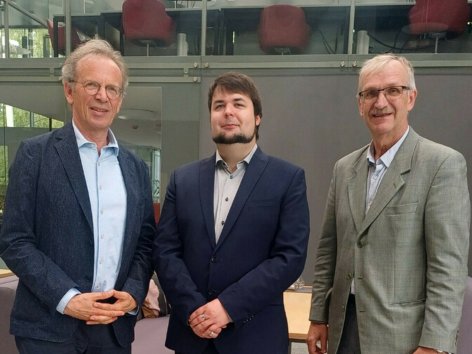Artificial intelligence delving into microscope images helps understand the functioning of drugs

For his doctoral thesis, Tõnis Laasfeld, along with colleagues, employed artificial intelligence to analyze millions of microscope images to observe how drugs function. The results of the study can be utilized in drug development to help create drugs without side effects or especially long-lasting drugs that patients need to take less frequently, write Tõnis Laasfeld, Ago Rinken, and Maikki Moosus in Novaator (in Estonian).
Today's drug developers have significantly more powerful tools at their disposal, thanks to the advancements in computer and data science, compared to years ago. Consequently, scientists now have significantly enhanced capabilities to discover the right drugs from an endless array.
In his recent chemistry doctoral thesis, Tõnis Laasfeld investigated how drugs and their target protein molecules on the surface of cells meet and interact. He combined biochemistry and information technology in his thesis, creating models and software for analyzing image data using machine learning. The developed solution assists in analyzing microscope images faster, more accurately, and more reproducibly.
"Half-jokingly, it can be said that during this doctoral thesis, a bunch of nerve cells were studied, meaning how to combine and teach artificial nerve cells or deep neural networks to investigate the functioning of biological nerve cells. Such mutual reflection between the natural and artificial worlds shows, on the one hand, that perhaps there isn't such a clear boundary between the natural and artificial. On the other hand, dealing with both fields is an almost limitless source of inspiration," added the fresh doctor.
For drugs, it's not only important if they work. Equally crucial is how quickly the effect manifests and how frequently the drug needs to be administered. To obtain such information, methods are needed to track the binding of the drug to the drug target over time, which the methods created in the doctoral thesis enable.
According to Laasfeld, the difference between previous static methods and new dynamic methods is analogous to the difference between a photo and a film. A photo can only suggest what preceded and could follow its creation, but a film provides a definite answer. By combining the temporal dimension with spatial dimensions in this way, it is possible to obtain even more new information. The downside is that the amount of data increases, requiring the assistance of artificial intelligence to extract information.
The video shows a stem cell model system used under a fluorescence microscope as a model for a nerve cell. The dull glow of the outer edge is the cell membrane composed of fat molecules, to which receptors with a glowing marker-like drug analogue are attached. Inside the cell are vesicles, about the size of the coronavirus, covered with a layer of fat molecules, which appear as brightly glowing dots.
Vesicles form when a part of the cell's own membrane invaginates with the receptor and the glowing drug analogue. From the video, it can also be noticed that many vesicles move in a quite specific direction, indicating that they are transported along intracellular "highways" by special motor proteins – actin filaments and microtubules.
Such methods offer interesting possibilities for drug development. Among other things, they could be particularly beneficial in the creation of long-lasting drugs to reduce their administration frequency. One potential long-acting drug analogue was found by Laasfeld and his colleagues for the muscarinic acetylcholine receptor, which regulates heart function.
The molecule of this drug candidate may remain attached to the receptor for several days. However, the property of prolonged action can be lost with even a tiny change in the molecule's structure. Designing such molecules is extremely difficult without knowledge of the receptor's behavior and structure.
Another interesting example concerns the well-known dopamine receptors, which bind the motivation molecule dopamine in the body. Simplistically, when a person achieves a self-set goal, the brain releases the same stimulant as a reward. The resulting euphoria encourages the person to undertake similar tasks in the future.
However, diseases like Parkinson's and narcotic substances such as cocaine disrupt the normal release of dopamine and its binding to the receptor. If a person becomes addicted to narcotics, the body tries to compensate for the excess dopamine release by reducing the number of dopamine receptors. In the short term, the cell pulls the receptor back inside, where the released dopamine can no longer affect the receptor.
With the microscope method developed in the study, it is possible to observe as a video what happens next and beyond the receptor. It turns out that, contrary to the common understanding, the receptor can carry the drug into the cell. At least some types of molecules can gather into vesicles inside the cell and remain there for much longer than one might think based solely on processes occurring on the cell surface.
These are just a few examples of interesting phenomena that were not known before because their discovery is not so straightforward. However, the methodology and software developed in the study already significantly accelerate the making and explanation of such discoveries. Therefore, even more exciting discoveries can be expected in this field soon.
On the other hand, the created software and methods have much broader applications. The new tools created in the doctoral thesis would allow demonstrating the effectiveness of various cancer therapies in both two-dimensional test tubes and more organ-like three-dimensional cell cultures.

Tõnis Laasfeld, a doctoral student at the University of Tartu's Institute of Chemistry, defended his doctoral thesis "Integrating image analysis and quantitative modeling for a holistic view of GPCR ligand binding dynamics" on August 29. The work was supervised by Professor Ago Rinken and Associate Professor Leopold Parts from the University of Tartu. The opponent was Professor Martin J. Lohse from the ISAR Bioscience Institute in Germany.






